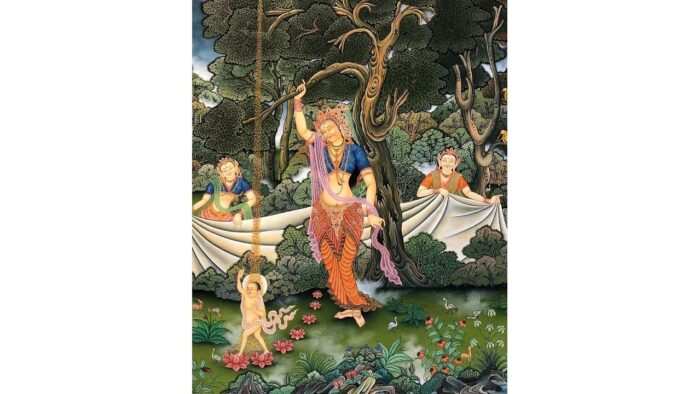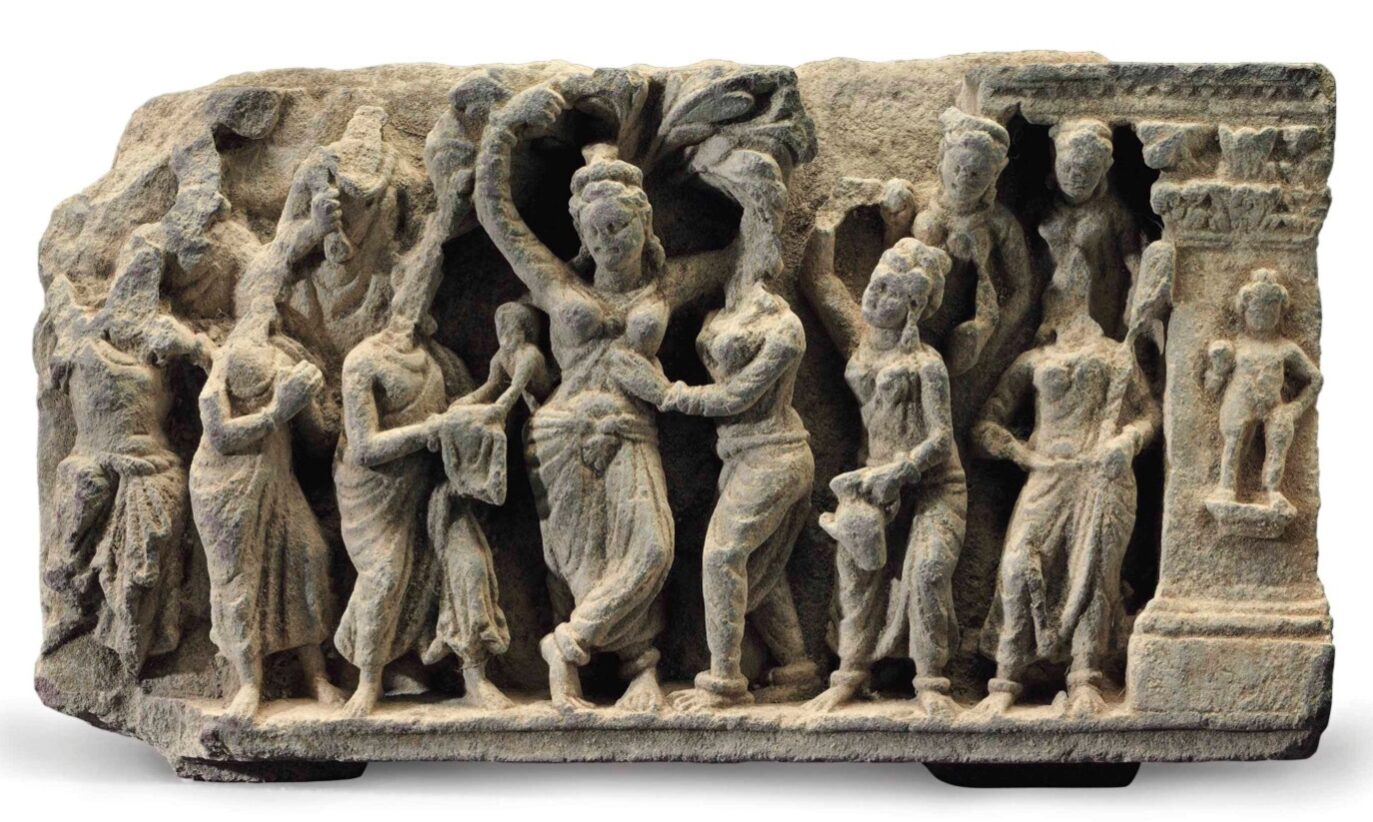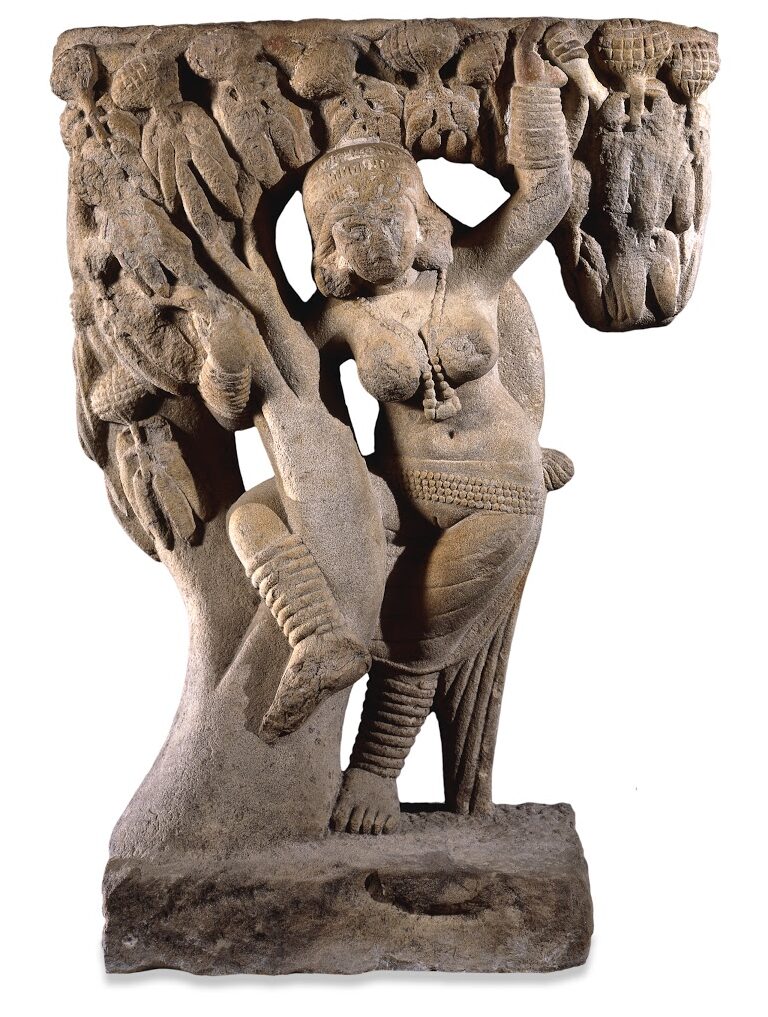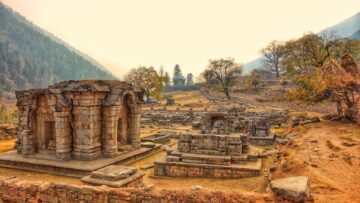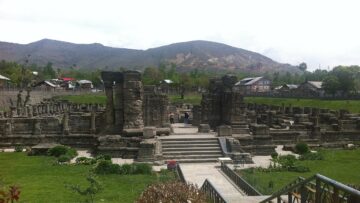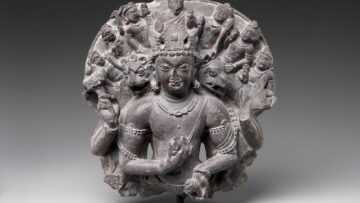Maya painfully trudged across the Lumbini grove pathway, gasping for air as she clutched her pregnant body. She was flanked by two attendants who were hauling her upright by holding her from under her arms. A concerned retinue of maids, midwives, soldiers and charioteers swarmed behind, concerned about their queen’s unexpected labour on their way to Devadaha. Maya’s eyes fell upon a blooming Sal tree in the grove and she gestured to her attendants to escort her to the Sal’s shade. The soldiers quickly set up a cloth screen around the Sal. Maya lumbered into the makeshift enclosure. Exhausted, she held onto a branch with all her strength as waves of pain rocked her body. After half an hour of excruciating labour, Maya heard the cry of her new born. She peered down at the midwife’s glowing face as she held up her son. The Great Śākya clan’s heir had made it safely into this world. Overwhelmed and dizzy, she gripped the branch tightly to keep herself steady. The branch snapped and Maya collapsed on the ground…unconscious.
[Figure 1: 2nd century Schist Panel from Gāndhar depicting Māyādevī giving birth to Gautama]
The time period coinciding with the flowering of new beliefs and ideologies in sixth century BC in the Indian subcontinent was also marked by new cultural flows in the society which was replicated in art, architecture and literature. The development of a religious pantheon around Gautam Buddha and its interaction with the ever-evolving Vedic pantheon led to the creation of new folklore, characters and motifs that were expressed in everyday life. The later Vedic and Mauryan period also marked the beginning of monumental architecture in India that served a larger socio-religious purpose. Naturally, the new motifs, narratives and symbols found their place in the architecture of the time and were abundantly reflected via sculpture.
One such intriguing motif is the figurine of Śālabhañjikā (शालभंजिका), which represents a young woman hanging from or holding onto a branch of a tree and is used as a decorative element. The Śālabhañjikā can be frequently spotted on pillars, columns and entry gateways of Buddhist architecture of the Mauryan period, eventually percolating into Hindu and Jain architecture too. The word Śālabhañjikā is a compound noun comprising of ‘Śāl’, denoting the Sal tree and ‘bhañjikā’ meaning ‘the one who breaks’ (used with feminine annotations). Śālabhañjikā is one of the most popular secular motifs that are found in Buddhist literature and architecture. The Śālabhañjikā on the toraṇa of the Sānchi stūpa is considered as one of the most recognizable depiction of the given motif.
[Figure 2: Elaborately decorated Śālabhañjikā statues were also reflective of the ornamental developments of the time. The ‘Mona Lisa’ or Gyaraspur Śālabhañjikā (10th century CE)]
The origin of the motif can be found in several texts but most noticeably in the Pāli Jātak Kathā which explains its direct connection to Buddhist architecture. There is a general consensus that in its earliest forms, it is a representation of Māyā, delivering Siddhārtha Gautama. According to Pāli Jātaka, there was an auspicious grove of Sāl trees, between the two towns of Kapilvastu and Devadaha. It was called the Lumbini Grove. The pregnant Queen Māyādevi’s convoy reached the grove where she took refuge under a blooming Sāl tree and held onto a low hanging branch while in labour. Overcome by the pangs of labour, she broke the branch while birthing Gautam Buddha. Thus, the earliest reference of the Śālabhañjikā motif is a representation of Buddha’s mother Māyādevi herself.
[Figure 3: Painting of Mayadevi birthing Gautama from the Lama Thanka School of Art]
The Śālabhañjikā also has a deep metaphorical significance as claimed by Buddhist texts. The act of breaking of a blooming branch during the birth of Buddha was symbolic of the recurrent theme of ‘karuņā’ in Buddhist philosophy. The breaking of a branch symbolized that pain was intrinsic in every life activity, so much so that even an auspicious occasion like the birth of Buddha wasn’t free from it. It signifies that pain is a part of life and the sooner one comes to term with it, the less it hurts the mortal beings.
However, the Śālabhañjikā has other origins too as one can find more references to the sculpture. In the 53rd story of the Avadānaśataka, which is a collection of hundred Buddhist tales in Sanskrit, we find another version of the motif. The story describes a festival of the same name which was being celebrated by the residents of Śrāvasti. It involved celebrations, singing and dancing of people in a grove where they collected Śāl blossoms. The story recounts the entry of Buddha into the grove to seek his daily alms. A Śeth’s daughter, upon noticing Buddha, showered him with the blossoms she had painstakingly collected. When she went to recollect her share of flowers, she accidently fell from the Śāl tree and sadly passed away. According to the tale, she had already paid respects to Buddha and was therefore ‘reborn among the gracious thirty-three gods’.
[Figure 4 : Śālabhañjikā’sculpture on the entry of Leshan caves, China built under the Tang Dynasty 713 – 803 CE.]
The story in Avadānaśataka is important from the socio-religious perspective for two reasons, firstly it refers to an already existing festival named ‘Śālabhañjikā’ being contemporary to Buddha, thereby suggesting an older pre-existing tradition that was probably manoeuvred or altered over time to fit a Buddhist narrative. Secondly, it again interpolates the narrative of ‘karuna’ (in this case, the death of a devotee) being intrinsic to a merrymaking festival. However, the historicity of tales in Avadānaśataka is unverified, and therefore the first argument might not hold true. Regardless of the potential doubts in the story of Avadānaśataka, the prevalence of a festival named ‘Śālabhañjikā’ cannot be denied as references of it exist elsewhere too.
[Figure 5: Śālabhañjikā sculpture from Satvahana dynasty (1st century BC – 3rd century AD)]
Śālabhañjikā references outside of the traditional Buddhist religious literary traditions include the famous work, Aśtādhyāyī by the famous Sanskrit grammarian, Guru Paṇini. Paṇini refers to Śālabhañjikā while explaining compound nouns. He provides examples of games that were played in eastern regions and lists ‘Śālabhañjikā’ and ‘Tālabhañjikā’ as two of them. The former involved collection of flowers. This can be considered as a worthy proof of the existence of a Śālabhañjikā festival too. The time period of the text being 500 BC, and the reference to ‘eastern regions’ both point towards the presence of a festival involving flower-collection in eastern India which was the stronghold of Buddhism. Other notable mentions of the term Śālabhañjikā occur in Sage Bharatmuni’s dance guide, Bharatnatyam. Bharatmuni refers to a shorter version of the word ‘Śālabhañji’ or ‘Śālastrī’. Other synonyms in epics and Vedic literature include ‘Stambhaputrika’, ‘putrika’, ‘putralika’, ‘pullalika’ etc.
[Figure 6: Śālabhañjikā from Bharhut, Madhya Pradesh]
To analyze Śālabhañjikā from the perspective of religion and society, it is also necessary to understand its usage in popular culture. Aśvaghośa’s Buddhaćarita (dated around 2nd century CE) contains usage of the term ‘Śālabhañjikā’ too. While describing Buddha’s Great Renunciation, Aśvaghośa describes the women who have fallen asleep out of exhaustion after their vain attempts to entice Prince Siddhartha with sensual pleasures. Aśvaghośa writes in the 52nd verse of Buddhaćarita:
“Another (woman) leaning on the side of the window, with her willow form bent like a bow, shining, as she laid with her beautiful necklace hanging down, like a Śālabhañjikā statue in an archway”
This verse has a much deeper connection with the term Śālabhañjikā and its meaning. Aśvaghośa uses the term to describe beautiful women who were enticing Siddhartha yet failing to obstruct the path to his renunciation. If closely compared to the positioning of a Śālabhañjikā on the gateways of Stūpas, it might denote an architectural metaphor that the path to god was filled with material temptations. Any devotee approaching the stūpa will enter the gateway and thus move away (both physically as well as mentally) from the temptations in the way. The visualization of ‘temptations’ as women is also reflective of the target audience of early Buddhist asceticism which was limited to male devotees.
[Figure 7: Śālabhañjikā on the toraṇa of the Sānchi stūpa, notice the similarity of style and placement with the Leshan Śālabhañjikā ]
The above interpretation can be verified from Pali Nidānakātha too. The Nidānakātha’s description of the same episode, puts the temptresses in a very different light as compared to that of Aśvaghośa. Nidānakātha presents the temptresses as malicious and repulsive (from a monk’s perspective), as they were creating obstructions in the path of renunciation. This was unlike Aśvaghośa who used positive literary ornamentation and romanticized language to describe the enticing women. Attention must also be drawn to Aśvaghośa describing the temptress’s position, ‘bent as a bow’ which is very reminiscent of the stance and shape of the Sanchi Torana’s Śālabhañjikā.
[Figure 8: A naturalistic representation of Śālabhañjikā. The more elaborately dressed and ornamented versions probably reflected the role of Śālabhañjikā as a temptress.]
Some scholars have also argued that the origin of the Śālabhañjikā figurine finds several parallels in the Greek architectural and literary traditions. Émile Charles Marie Senart has observed the similarity in aspects of Śālabhañjikā with the Greek myth of Leto. According to Senart, the aspect of Maya giving birth under a tree is similar to the legend of Leto giving birth to Artemis and Apollo in Greek Literary traditions. Leto was cursed by Zeus’s wife Hera that she would be able to give birth to the twins born out of wedlock with Zeus, neither on land or water and not under the sun. Therefore, she birthed her twins while hanging from a tree on an island under the shade of the foliage.
[Figure 9: Leto with her children, by William Henry Rinehart]
While this may be a pure coincidence, prevalence of Indo-Greek cultural contacts might make this explanation reliable. In fact, scholars have traced Indo-Hellenistic fusion of art to the cult of Yakśa and Yakśiṇī. Several sculptural stances of Yakśiṇīs, Darpaṇsundarīs (lady holding the mirror) and Hansbhāshinis (lady talking to a swan) have parallels in Greek art. John Hendrik Caspar Kern also compared the Śālabhañjikā to the Caryatid of Greek architecture. However, unlike Caryatids which essentially served as columns and were a structural element, Śālabhañjikā continued to be an ornamental figure only.
[Figure 10: Śālabhañjikā’s usage in Hindu iconography as ‘Śhilābālikā’. Śhilābālikā from Chennakeśava at Belur]
At historical sites Śālabhañjikās are manifested in various forms like Yakśiṇīs, Vrkśa Devatā, Dohadāriṇi etc. All of these are female sculpture figurines that were used in architecture and had slightly deviating interpretations. It is important to distinguish between Yakśiṇīs and Śālabhañjikās. While Yakśiṇīs might simply be tree nymphs standing under foliage, Śālabhañjikā sculptures had identifiable depiction of the broken branch. Stylistic variations occur in the depiction of the tree. For instance in Sanskrit works Lalitavistara and Māhāvastu, the Śāl tree has been replaced by a Palāksha (Ficus infectoria). This might be accorded to regionalism within art and the artist trying to relate locally important flora within the borrowed cultural trend of Buddhism.
[Figure 11: 11th century panel depicting birth of Buddha Shakyamuni. Representation of Buddha’s birth often show his delivery from the side of Maya’s abdomen as opposed to a vaginal birth, it is seen as a metaphor for Buddha’s birth being divine as compared to that of mere mortals.]
Eventually we come across the most popular interpretation of the Śālabhañjikā which is that of a ‘fertility goddess’. Textual traditions refer to Śālabhañjikā as a celestial nymph/mythical fairy who welcomes spring by touching trees and plants and making them bloom. Thus, her most popularized depiction is that of a young woman swinging or hanging from a flower or fruit laden branch. This depiction is seen from Gāndhār to Sānchi. The fertility goddess cult is a quite common aspect of any Neolithic and post-Neolithic civilizations, especially ones that depend on agriculture.
[Figure 12: Śālabhañjikā pointing towards her womb, showing the amalgamation of the fertility goddess cult and the Buddhist imagery.]
The other extended version of the Śālabhañjikā was the Vrkśa Devatā. Unlike popular understanding the word ‘Devatā’ doesn’t always signify a male deity. As it ends with an ‘aa’ suffix, it can be used to refer to female deities as well, as in this case. The Vrkśa Devatā, as the name suggests were tree nymphs that were representative of two similar themes, their own procreativity and that of the nature too. In special instances when Vrkśa Devatā-s held a branch of an Ashoka Tree they were known as ‘asokadohada’. Here, the prakrit word ‘dohada’ means ‘two-hearted one’ and refers to the longings of a pregnant woman, along with the longings of her child. This is a surprising amalgamation of the ‘Maya’ understanding of Śālabhañjikā with that of a fertility goddess.
[Figure 13: Celestial Nymph or ‘Devata’ (Apsara) sculpture from Chandela period. Later female sculptures were modelled on the earlier Śālabhañjikā/Yakshi representations.]
Example of Dohadarkśa devata form of Śālabhañjikā is seen in Bharhut in Madhya Pradesh. Termed as Chandra Yakshini, this dohada sculpture lightly holds the branch of the tree while the other hand touching her genital area, as if pointing to her womb. She stands gracefully, her head covered in a wrap and a long clearly carved braid of hair hanging on the side. An assortment of jewels can be seen on her neck, wrist and ankles and bands of cloth are knotted on her waist, the ends pleats of which hang down. Another Vrakshdevata Śālabhañjikā is famously seen at the east toraṇa of Sānchi Stūpa I at Madhya Pradesh. She is seen holding a mango branch. Unlike Bharhut Śālabhañjikā, this one is completely nude, except her detailed jewels and a scarf. It is argued that the association with mango-laden trees is suggestive of the notion of ‘abundance and general auspiciousness’.
[Figure 14: Ornamentational details of the Chandra Yakshi from Bharhut]
Thus, Śālabhañjikā represents a very cohesive socio-religious motif. It is a good object of study for depiction of how women were viewed within the purview of religion and renunciation. On one hand we see Śālabhañjikā being praised as the progenitor of human race and Buddha himself, delicately placed and revered in the form of Māyā and on the other hand we see Śālabhañjikā being used as an adjective for obstructions in Buddha’s path to renunciation. Śālabhañjikā eventually percolated into Hindu and Jain architecture and is referred by Banabhatta in Harshacharita, Kalidasa in his plays, Kalhana in Rajatarangini and several other textual traditions. It continues to be a major ornamentational motif even in Dravidian architecture which shows the development and spread of the cult via the spread of Buddhism in post-Mauryan times.
[Figure 15: Statue of Mayadevi from Nepal (19th century). Notice Buddha’s birth from the side of Maya’s abdomen]
Disclaimer: The opinions expressed in this article belong to the author. Indic Today is neither responsible nor liable for the accuracy, completeness, suitability, or validity of any information in the article.

